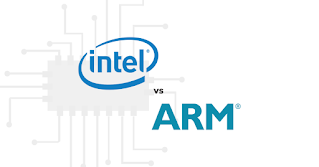Through this article, I will try to differentiate between ARM architecture-based processors and Intel(x86 architecture-based) processors. Some of the ARM architecture-based processor manufacturers are Qualcomm, MediaTek, Samsung, and Apple.
The Difference between ARM and x86 Processors
The primary difference between ARM architecture-based and x86 architecture-based processors is that ARM processors follow a RISC (Reduced Instruction Set Computer) architecture while x86 processors are CISC (Complex Instruction set Architecture). This means that the ARM ISA(Industry Standard Architecture) is relatively simple and most instructions execute in one clock cycle while CISC instructions are mostly complex, taking up multiple CPU cycles to execute each instruction. ARM processors follow the explicit load-and-store model, meaning any operation between two data objects in memory requires explicitly loading the data from memory to processor registers, performing the operation, and explicitly storing the data back into memory. In x86 processors, the load-and-store-into-register logic is inbuilt into the more complex instructions thus allowing lesser instructions. Of course, this means that CISC processors need to have more hardware logic to decode and execute the complex instructions that they have while putting lesser effort into the compiler.
In simple words, the x86 processors are geared for mainstream devices where factors like heat dissipation, power draw constraints, and expandability are not needed to be addressed. They are brute powerhouse devices that run heavy computing or load tasks.
ARM processors are low-power processors designed to run in specific devices to perform specific tasks or functions that are not critical or heavy (workload).
Let us go to some more differences between Intel x86 architecture-based processors and ARM processors.
Power Consumption
The ARM processors use less power life thanks to their single-cycle computing set in comparison to x86 architecture-based processors. They also have a reduced operating temperature than the Intel processors.
Intel's x86 architecture-based processors are focused on performance, and that's what most PC or laptop users expect from them. Power consumption isn’t a problem at all because the computer is constantly connected to power.
ARM processors on the other hand are perfect for mobile devices as they reduce the power consumption to keep the system operational and perform the user’s requested tasks.
Speed
ARM architecture-based chipsets are usually slower than Intel's x86 architecture-based counterparts. This is because they are designed to consume low-power whereas Intel processors are designed for faster computing.
Most users don't notice a difference in their respective devices because of the software coming with the devices are optimized for the respective processors coming inside them.
Intel vs ARM: Operating System Switch
It is very clear that ARM processors are dominant in the Mobile Devices market-share i.e., Android and iOS, and Intel's x86 architecture-based processors are dominant in PC and Laptops market share i.e., Windows. But ARM and Intel processors have come up with other OS also. Let us know about it.
Intel in Android Devices
Intel was once a part of a few Android mobile devices. Intel-based devices can run the full range of Android apps, even ones that were originally written for the ARM architecture. However, if an app contains an ARM-specific code, then it must be translated before it can be executed.
This takes time and energy to do, so battery life and overall performance may suffer.
ARM in Windows Devices
Microsoft also created some Windows Mobile devices that were based on ARM processors. But for this to be done, they have had to perform some changes to the original Windows. In the ARM-based tablet, you get a cut-down variant of Windows called Windows RT, which can run full-screen apps from the Windows Store but not regular desktop software.
But in 2019, things changed. Microsoft launched the Surface Pro X tablet with an ARM processor that runs full Windows rather than a watered-down version.
Which is better between Intel x86 architecture and ARM architecture-based processors?
I will say, it depends. It depends on who you are. It depends on what kind of device you want. It depends on why you want the device. The answer to this question changes respectively with the situations and needs.
Intel is faster and more powerful than ARM processors. But, ARM processors are more mobile-friendly than Intel processors.
The End Notes
I hope you loved this article. If you get to know anything from this, that means my hard-work of writing this article is successful. Otherwise, if you have any queries related to this please comment down below and I will try to answer every question. Please share this article with your friends, mates, and buddies. Keep learning and keep visiting. Have a good one. Cheers!



0 Comments
Please share your views.